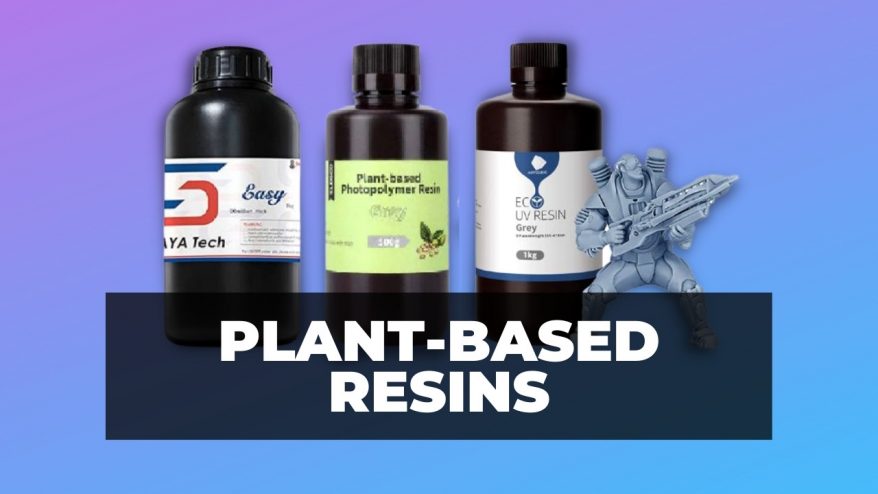
Being environmentally conscious is at the forefront of many people’s priorities these days, and it’s the little changes that can really add up – such as using plant-baed resins rather than standard ones.
3D printing companies and enthusiasts alike are opening themselves up more and more to these changes, and so there’s recently been a huge focus on eco-friendly resins.
In FDM, recyclable or biodegradable filaments have come about – and so we’ll look at some of the best plant-based resins available today, and how you can be more environmentally friendly with resin 3D printing, and how they work.
What is Plant-Based/Eco-Friendly Resin?
Plant-based resins are 3D printer resins that are made primarily from oils. These oils come from soybeans and corn in most cases, but can also come from sunflowers, whey, potatoes, beets, and even algae.
By creating 3D printer resin with plants, we end up with eco-friendly materials that are recyclable, biodegradable, and ready to make the high-resolution print projects you know and love.
Plant-Based vs Standard Resins: The Differences
Standard 3D printer resins are made with a variety of chemical compounds to achieve the look, color, and properties ideal for printing with resin. Like many plastics, these polymers are often toxic made using non-eco-friendly methods that leave them unrecyclable and hazardous to both the environment and your health.
Typical SLA resins pose the same danger to the environment as plastic. Through irresponsible disposal and misuse, they are a real threat to the planet and are generally considered to be toxic waste in the worst of cases.
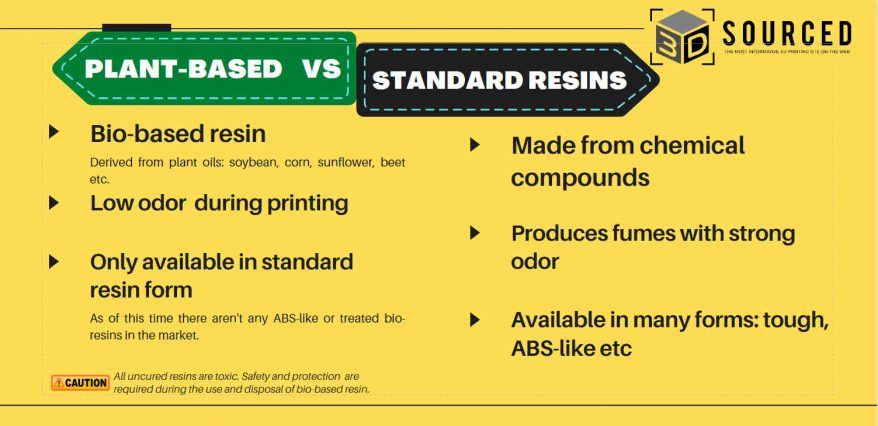
This is why environmentally friendly ‘bio-resins’ are becoming more and more popular and widely available as they’re now much easier to find on online marketplaces and have costs comparable with standard UV resins. Not only are the plants from which they’re made found in abundance, but they’re also fairly cheap to produce.
It wasn’t that long ago that eco-friendly resins were a niche market, hard to find and often expensive. Now, these resins are found in most marketplaces by well-known brands, and often for a price similar to that of more traditional materials.
In essence, plant-based resins are an excellent substitute for standard resins with basically no downsides aside from occasionally being slightly more expensive. Aside from that, you’ll find the same top-quality as many other resins on the market, meaning nothing has been sacrificed for greener, more eco-conscious printing.
As of writing, these bio-resins are only really available in standard resin form, meaning you’re not likely to find ABS-like or particularly tough ‘treated’ resins on the market just yet. But we’ve got high hopes for the ever-greener-looking future!
Are Eco-Resins 100% Environmentally Friendly?
Despite eco-friendly resins being a great step forward, the sad answer to this question is no. The ‘plant-based’ nature of eco resins is only the tip of the iceberg, as currently the plant oils they’re made from only make up around half of the total composition.
While still a viable, safer, and far more eco-friendly alternative to standard resins, eco-resins still have a long way to go before they can be considered 100% environmentally sound.
Don’t be discouraged, though, the lowest quantity of these oils I could find in any given resin was 45% soybean oil in Anycubic’s plant-based eco-resin. This is still a heck of an improvement over the typical compounds we’ve all been using for years.
How to 3D Print with Eco-Resin
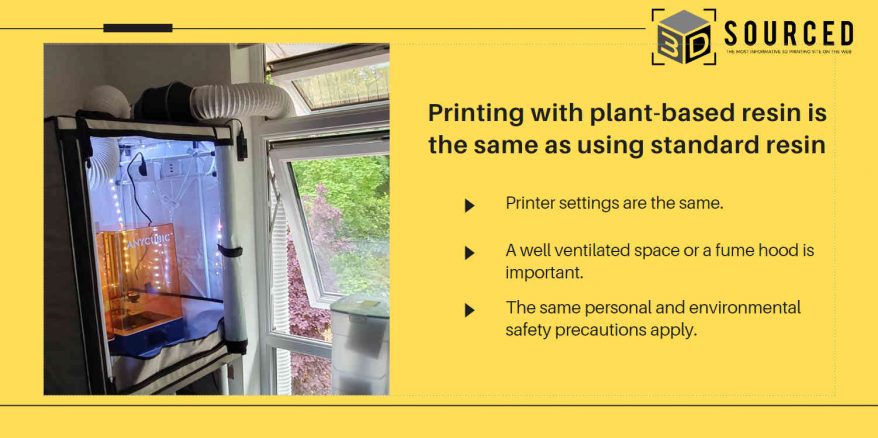
You can treat eco-resins as standard resins in terms of printer settings. The two are functionally identical, and thus carry some of the same risks.
In the same way that you can use plant-based resins with your 3D printer just like normal resins, you should also keep up the same safety precautions you’ve hopefully been using thus far.
These precautions include using a well-ventilated space for your printing, as well as wearing protective gloves, masks, and even eyewear if you’re particularly worried.
Are Plant-Based Resins Toxic?
Make no mistake, all resins are toxic when uncured. The toxicity and general hazards vary from brand to brand, and plant-based resins are not without their dangers.
Depending on what they’re made from, even plant-based resins can irritate the skin and eyes, and even cause respiratory damage if not handled with care before and during printing.
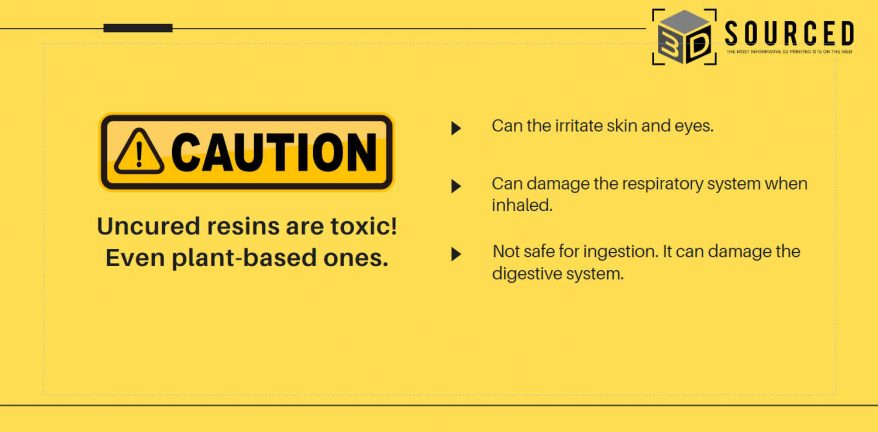
Just like how you still wouldn’t ingest plant-based resins, you should still be careful when using them. Resins, even plant-based ones, should never come into direct contact with the skin until fully cured, and even then you should still avoid contact with your eyes and mouth.
Research into potential medical applications of plant-based resins has been conducted, but even that hasn’t proven to be fully safe or even consistent when using the purest of currently available compounds.
Now that you know all the basics (and warnings) of using plant-based resins, the main problem now is which brand to choose. Here we’ll look at some of the best and most reliable bio-resins on the market today, and which you should go for.
Because readily available plant-based resins are still a fairly new concept, there isn’t quite as much choice out there as there are for other types like water-washable and ABS-like resins, so be sure to choose wisely!
Best Plant-Based Resins
3DSourced is reader-supported. When you buy through links on our site, we may earn an affiliate commission. Learn more
Anycubic Eco-Resin
- Price: Check price on Amazon here / Also available at Anycubic here
- Available Colors: White, Black, Translucent Green, Gray, Pink, Yellow, Clear
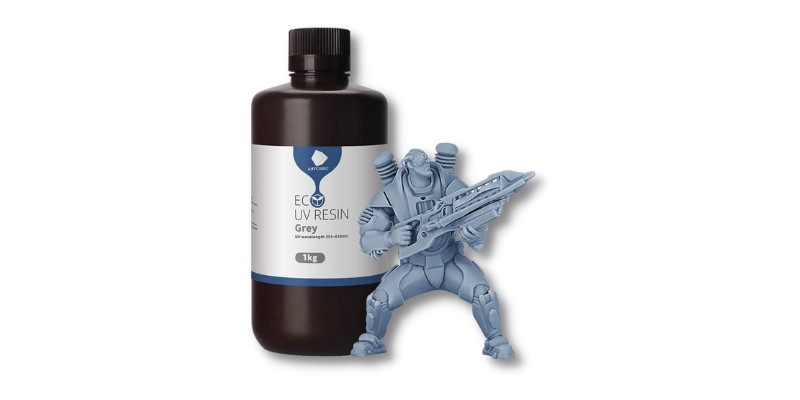
Pros
Low shrinkage, high compatibility, impressive quality, and natural biodegradability.
Low odor.
No print quality and resolution sacrifices are made for environmental friendliness.
Cons
The range of colors isn’t quite as exciting as their standard resin or Resin+ lines.
Anycubic offers one of the most extensive ranges of 3D printer resins, one of which is, naturally, their soybean oil-based Eco-Resin.
With its low shrinkage, high compatibility, impressive quality, and natural biodegradability, it’s easy to see why Anycubic’s affordably priced eco-resin is at the top of many people’s lists.
While the range of colors available isn’t quite as exciting as their standard resin or Resin+ lines, they do offer quite a bit of variety, including the ever-popular (and frankly my favorite) translucent green.
While Anycubic’s resins are known for their low odor, their plant-based resin goes a step further, taking advantage of their own formula to further remove the unpleasant smells from their plant-based resin, which is already naturally low on the stink scale.
Anycubic also doesn’t sacrifice print quality and resolution for environmental friendliness, and is a great resin to go for if you want top-quality prints while maintaining a clearer conscience.
Anycubic is also a model of affordability. While originally around $70 per kilogram (0.9L), it will now only set you back around half that at $36. Compare this to their standard resin price of $32/kg, and you can see it’s one heck of a deal.
Elegoo Plant-Based Resin
- Price: Check price on Amazon here
- Available Colors: White, Black, Gray, Clear Green, Translucent
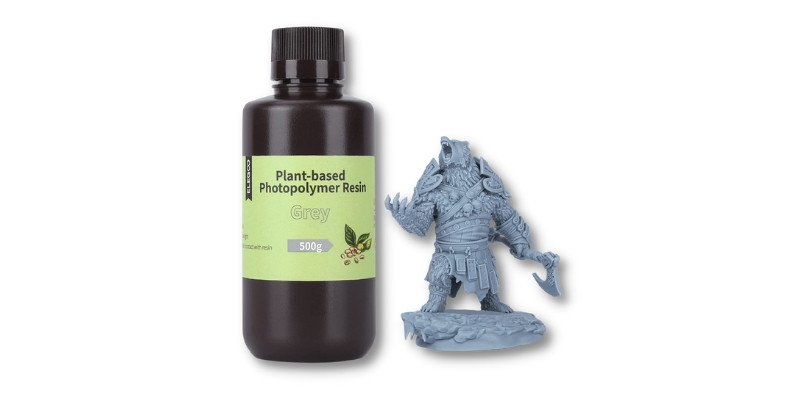
Pros
Fat curing and low emission rates.
Similar to Anycubic’s eco-resin, but cheaper.
Cons
Low color variations.
Like Anycubic, Elegoo resins are known for their high resolution, print quality, color variation, and affordability.
Elegoo’s plant-based resin is fast-curing and has very low emission rates, making it one of the safest bio-resins on this list without you having to take any extra steps. Don’t be fooled, though, remember that there’s no such thing as a fully non-toxic resin (yet).
With similarly low shrinkage, color variation, and print quality to Anycubic’s eco-resin, the main reason to go for Elegoo here is its price.
Sold in bottles as small as 500g, it’s a great under-$20 option if you either don’t want to buy much at once, or are just looking to test out plant-based resin for yourself before committing to it as a regular-use material.
As for color options, there aren’t quite as many to choose from as their standard resins, which are known to be numerous at around 10 colors for each standard resin. If you’re looking for vibrant projects, I recommend the clear green. It’s vibrant, brilliant, and quite eye-catching.
Of course, you could also opt for their translucent resins for some cool unique projects too. Though these recommendations are coming from a writer who’s getting a little sick of white and gray, so you don’t have to take these recommendations as gospel.
Be advised that while Elegoo does advertise their eco-friendly resin as being low-irritant and virtually odor-free, I still absolutely recommend taking the usual precautions we mentioned above like good ventilation, protective gloves, and generally careful handling
Siraya Tech Plant-Based Eco-Friendly Resin
- Price: Check price on Amazon here
- Available Colors: Gray, Obsidian Black
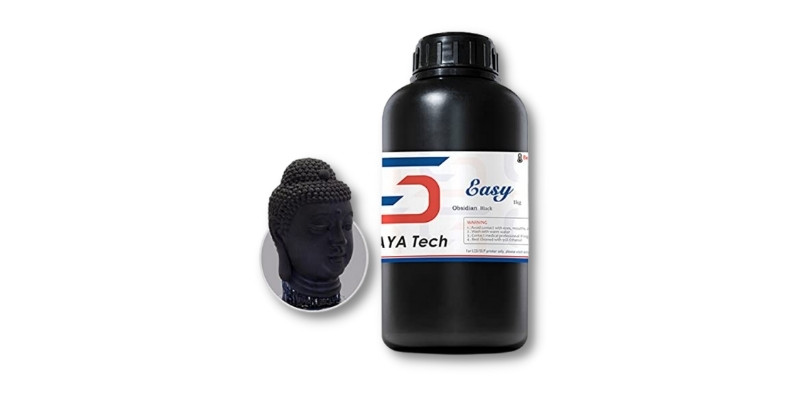
Pros
Low-odor and fast-curing.
Insanely high-quality results.
Hassle-free, environmentally-friendly resin that won’t disappoint.
Cons
Extremely low color variations.
Expensive.
While the most expensive (even if only marginally) and more boringly colored plant-based resin on this list, the lesser-known Siraya Tech’s eco-friendly resin is still very much worth a look.
As well as being low-odor and fast-curing like its competitors, Siraya is very easy to clean, needing very little post-processing for some insanely high-quality results.
Of course, due to its extremely limited color options, you will need to properly treat and paint your projects if you want them to stand out.
The key to Siraya’s plant-based resin is how insanely easy it is to use. Advertised as being perfect for students, educators, or just straight-up beginners, it’s a pretty great option if you’re still new to 3D printing or are looking to start out with plant-based resins on the right foot.
Overall, Siraya Tech is a good, hassle-free, environmentally-friendly resin that won’t disappoint and offers a great toe-dipping experience for those of you unsure of where to begin.
It’s also highly compatible and should work just fine with any resin printer, eliminating the guesswork for those of you who’ve had trouble finding compatible materials in the past.
This beginner-friendliness is further proven by Siraya Tech’s excellent support network, which is keen to hear from users and answer their questions as clearly as possible. All in all, this is the plant-based resin for you if you happen to need a helping hand in learning or teaching about eco-friendly resins as well as just resins in general.
Related posts:




